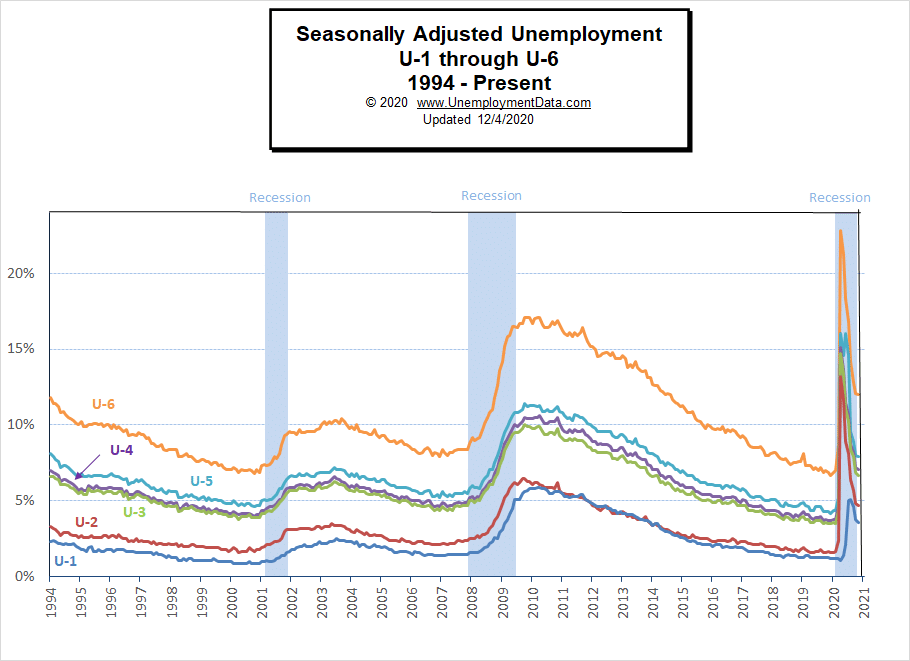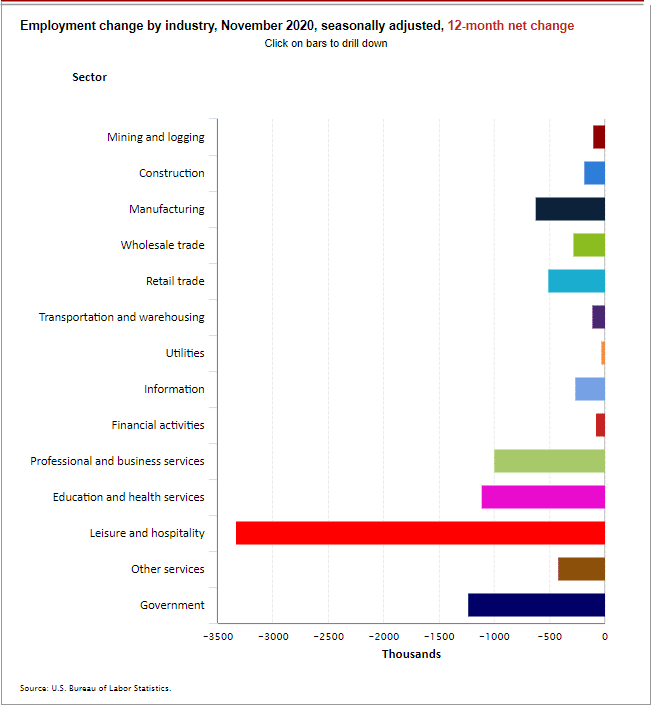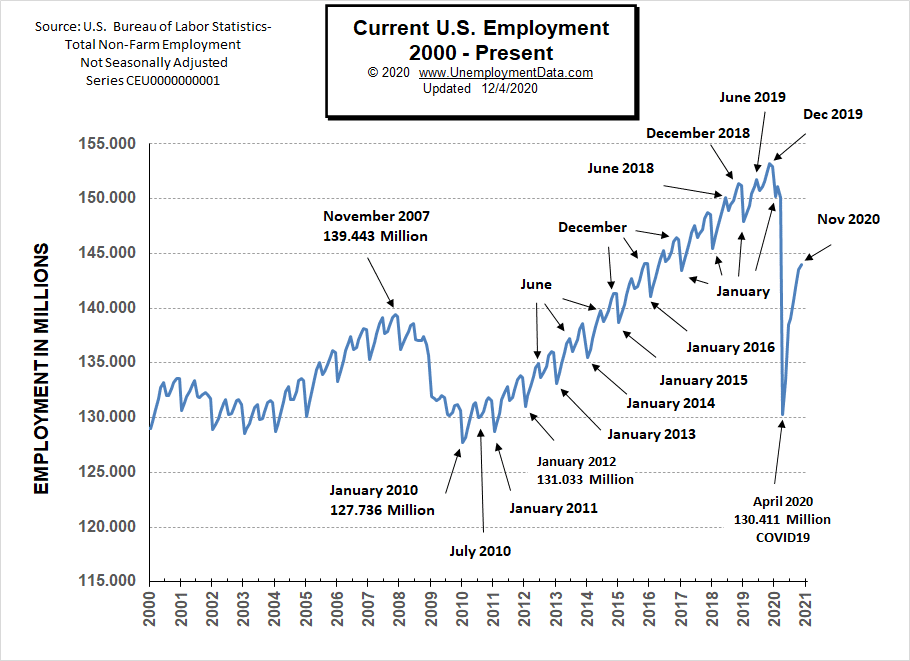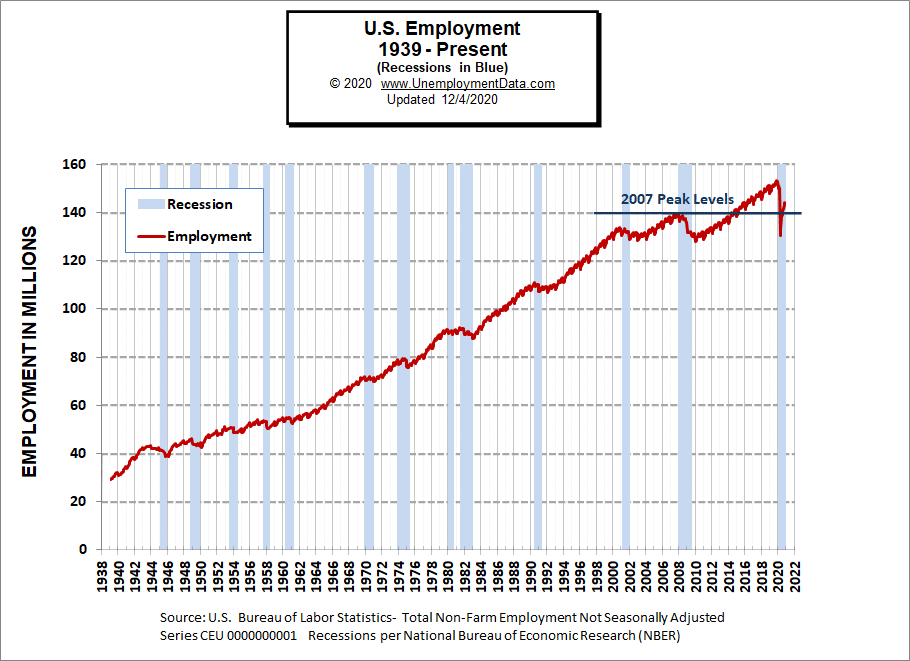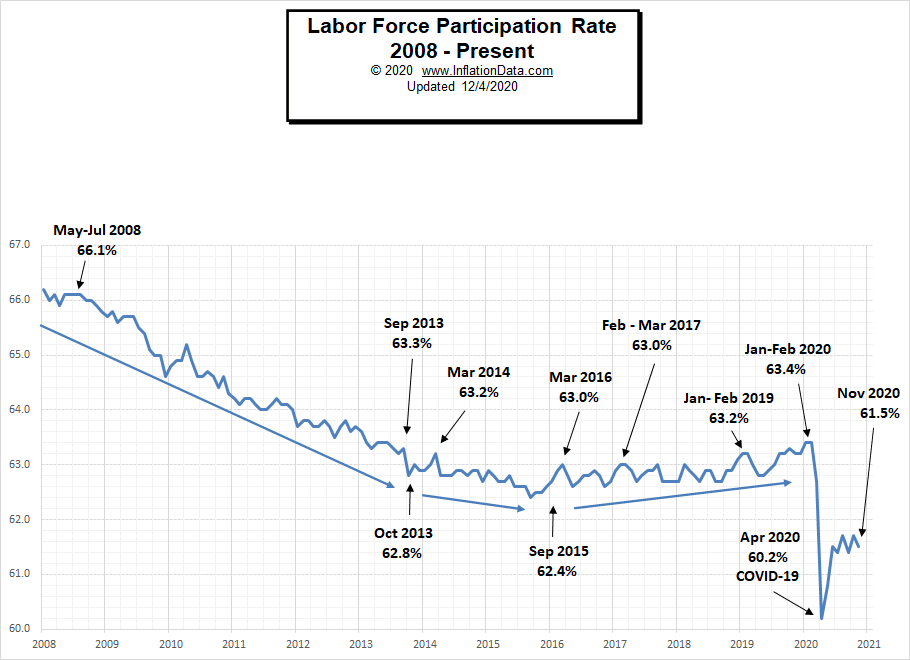The U.S. Bureau of Labor Statistics (BLS) released its employment / unemployment report for November on December 4th.
- Unadjusted U-3 was Down from 6.6% to 6.4%
- Adjusted U-3 was Down from 6.9% to 6.7%
- Unadjusted U-6 was unchanged at 11.6%
- Labor Force Participation fell from 61.7% to 61.5%
- Unadjusted Employment up from 143.488 million to 144.005 million
According to the Commissioner of the U.S. Bureau of Labor Statistics:
“Nonfarm payroll employment increased by 245,000 in November, and the unemployment rate edged down to 6.7 percent. These improvements reflect the continued resumption of economic activity that had been curtailed due to the coronavirus (COVID- 19) pandemic and efforts to contain it. However, the pace of improvement in the labor market has moderated in recent months.”
Of course, they are talking about “Seasonally Adjusted Jobs” from the “Current Population Survey (CPS)” rather than looking at the results reported by actual companies in their “Current Employment Statistics survey (CES)”
But looking at the CES report we see…
Originally the BLS reported 143.459 million jobs for October, this month they only adjusted that slightly.
So currently they are saying 143.488 million jobs for October and 144.005 million for November.
which is actually an increase of 546,000 jobs based on their original estimates.
U1 through U6 Unemployment Rates
Due to COVID, all the various measurements of Seasonally Adjusted Unemployment from U-1 through U-6 spiked up sharply beginning in April except U1 which measures unemployment longer than 15 weeks. In July, they began falling rapidly. In November they only fell slightly due to renewed restrictions by several states.
For more information about the various measurements of unemployment see What Is U-6 Unemployment?
Employment by Sector
The employment “bubble chart” gives us a good representation of how each sector of the economy is doing (employment wise on a seasonally adjusted basis).
The best-performing sectors in November were Transportation & Warehousing which gained 145,000 jobs, and Professional and Business Services with a gain of 60,000 jobs and Education & Health Services with a gain of 54,000 jobs. Other gainers were Construction 27,000, Manufacturing 27,000, and Leisure $ Hospitality 31,000.
Retail was the big loser -34,700 jobs.
Average weekly wages rose again in November to $1029.38 from October’s $1,026.60 from $1,022.61 in September, August was $1,019.66 and July was $1,013.96.
(See the table below for details.)
How to read this chart:
The bubbles location on the chart tell us two things:
- Change in Employment Levels over the most recent month.
- Average Weekly earnings.
- The further to the right the bubble the larger the increase in the number of jobs.
- The higher up on the chart the larger the average salary.
Bubble Size tells us:
- Total Employment for the sector.
- Larger bubbles mean more people are employed in that sector.
Employment and Average Weekly Earnings by Industry
November 2020, Seasonally Adjusted
| Industry | Monthly Increase | Average Weekly Earnings | Employment Level |
| Total Private Employment | 344,000 | $1,029.38 | 121,197,000 |
| Mining and Logging | 1,000 | $1,551.27 | 624,000 |
| Construction | 27,000 | $1,242.47 | 7,360,000 |
| Manufacturing | 27,000 | $1,166.28 | 12,253,000 |
| Wholesale trade | 10,400 | $1,262.99 | 5,653,300 |
| Retail trade | -34,700 | $651.68 | 15,122,100 |
| Transportation and Warehousing | 145,000 | $993.67 | 5,555,400 |
| Utilities | -100 | $1,931.18 | 538,700 |
| Information | 1,000 | $1,640.91 | 2,614,000 |
| Financial Activities | 15,000 | $1,470.42 | 8,730,000 |
| Professional and Business Services | 60,000 | $1,293.08 | 20,489,000 |
| Education and Health Services | 54,000 | $962.79 | 23,330,000 |
| Leisure and Hospitality | 31,000 | $439.89 | 13,418,000 |
| Other Services | 7,000 | $857.63 | 5,509,000 |
Another way to look at these monthly numbers. This one includes another decrease in government jobs on top of last month’s decrease. (note that Utilities are slightly negative and Information is slightly positive):
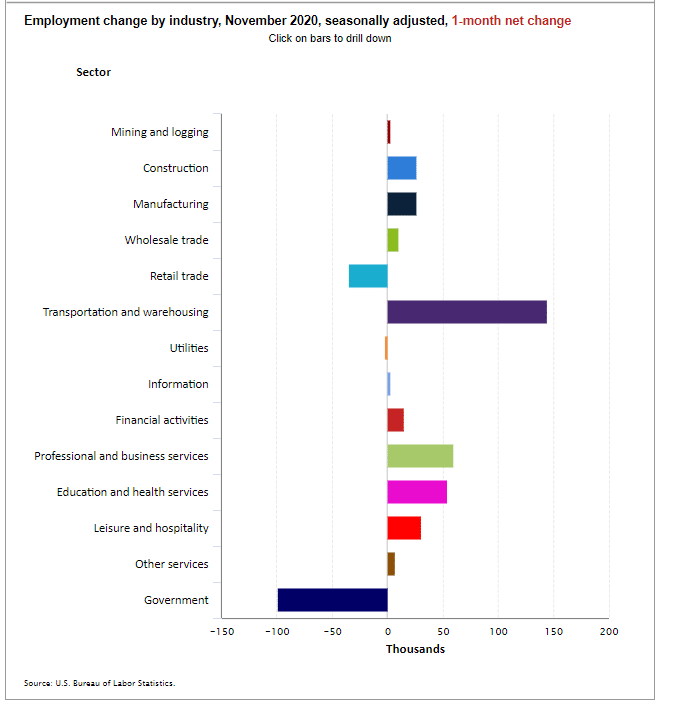
Source: BLS
Current Employment
Typically the low point for each year occurs in January and then it moves almost straight up to a small peak around June with a slight drop around July and then the highest peak in employment happens in November/December.
But the COVID virus has shortcircuited the normal trend and we saw a drop which began in March and by April it took employment back down to approximately the level of July 2010. June saw employment rebound to approximately the January 2015 level. Fortunately, July did not follow the traditional pattern but instead rose (although only slightly) rather than falling. August’s employment rose to roughly the January 2016 level. November’s Employment was slightly above the October level.
See Current Employment for more info.
Previous Record Low Unemployment (Seasonally Adjusted U-3)
If we consider anything 4% or below as “low” we have had a few “low” stretches as we can see in the table below.
(4% or below in Green)
| Jan | Feb | Mar | Apr | May | Jun | Jul | Aug | Sep | Oct | Nov | Dec | |
| 1950 | 6.5% | 6.4% | 6.3% | 5.8% | 5.5% | 5.4% | 5.0% | 4.5% | 4.4% | 4.2% | 4.2% | 4.3% |
| 1951 | 3.7% | 3.4% | 3.4% | 3.1% | 3.0% | 3.2% | 3.1% | 3.1% | 3.3% | 3.5% | 3.5% | 3.1% |
| 1952 | 3.2% | 3.1% | 2.9% | 2.9% | 3.0% | 3.0% | 3.2% | 3.4% | 3.1% | 3.0% | 2.8% | 2.7% |
| 1953 | 2.9% | 2.6% | 2.6% | 2.7% | 2.5% | 2.5% | 2.6% | 2.7% | 2.9% | 3.1% | 3.5% | 4.5% |
| 1954 | 4.9% | 5.2% | 5.7% | 5.9% | 5.9% | 5.6% | 5.8% | 6.0% | 6.1% | 5.7% | 5.3% | 5.0% |
| 1955 | 4.9% | 4.7% | 4.6% | 4.7% | 4.3% | 4.2% | 4.0% | 4.2% | 4.1% | 4.3% | 4.2% | 4.2% |
| 1956 | 4.0% | 3.9% | 4.2% | 4.0% | 4.3% | 4.3% | 4.4% | 4.1% | 3.9% | 3.9% | 4.3% | 4.2% |
| 1957 | 4.2% | 3.9% | 3.7% | 3.9% | 4.1% | 4.3% | 4.2% | 4.1% | 4.4% | 4.5% | 5.1% | 5.2% |
| 1958 | 5.8% | 6.4% | 6.7% | 7.4% | 7.4% | 7.3% | 7.5% | 7.4% | 7.1% | 6.7% | 6.2% | 6.2% |
| … | … | … | … | … | … | … | … | … | … | … | … | … |
| 1965 | 4.9% | 5.1% | 4.7% | 4.8% | 4.6% | 4.6% | 4.4% | 4.4% | 4.3% | 4.2% | 4.1% | 4.0% |
| 1966 | 4.0% | 3.8% | 3.8% | 3.8% | 3.9% | 3.8% | 3.8% | 3.8% | 3.7% | 3.7% | 3.6% | 3.8% |
| 1967 | 3.9% | 3.8% | 3.8% | 3.8% | 3.8% | 3.9% | 3.8% | 3.8% | 3.8% | 4.0% | 3.9% | 3.8% |
| 1968 | 3.7% | 3.8% | 3.7% | 3.5% | 3.5% | 3.7% | 3.7% | 3.5% | 3.4% | 3.4% | 3.4% | 3.4% |
| 1969 | 3.4% | 3.4% | 3.4% | 3.4% | 3.4% | 3.5% | 3.5% | 3.5% | 3.7% | 3.7% | 3.5% | 3.5% |
| 1970 | 3.9% | 4.2% | 4.4% | 4.6% | 4.8% | 4.9% | 5.0% | 5.1% | 5.4% | 5.5% | 5.9% | 6.1% |
| … | … | … | … | … | … | … | … | … | … | … | … | … |
| 1999 | 4.3% | 4.4% | 4.2% | 4.3% | 4.2% | 4.3% | 4.3% | 4.2% | 4.2% | 4.1% | 4.1% | 4.0% |
| 2000 | 4.0% | 4.1% | 4.0% | 3.8% | 4.0% | 4.0% | 4.0% | 4.1% | 3.9% | 3.9% | 3.9% | 3.9% |
| 2001 | 4.2% | 4.2% | 4.3% | 4.4% | 4.3% | 4.5% | 4.6% | 4.9% | 5.0% | 5.3% | 5.5% | 5.7% |
| … | … | … | … | … | … | … | … | … | … | … | … | … |
| 2018 | 4.1% | 4.1% | 4.1% | 3.9% | 3.8% | 4.0% | 3.9% | 3.9% | 3.7% | 3.7% | 3.7% | 3.9% |
| 2019 | 4.0% | 3.8% | 3.8% | 3.6% | 3.6% | 3.7% | 3.7% | 3.7% | 3.5% | 3.6% | 3.5% | 3.5% |
| 2020 | 3.6% | 3.5% | 4.4% | 14.7% | 13.3% | 11.1% | 10.2% | 8.4% | 7.9% | 6.9% | 6.7% |
Historical Employment
Historically employment is closely tied to recessions and that is no accident. One of the primary factors in calculating whether the economy is officially in a recession is an increase in the unemployment rate. The chart below provides the Historical Employment Data overlaid on blue bars showing periods of official recessions. In April, the number of people employed fell below the 2007 peak, near the lows of the 2008-2010 crash. In August it rebounded back above the 2007 peak level. According to the National Bureau of Economic Research (NBER) we have officially been in a recession since February. Since they measure a recession beginning from the peak, that just means the economy is no longer growing, which is pretty obvious due to the virus.
See Historical Employment Data for more info.
Current Seasonally Adjusted Unemployment
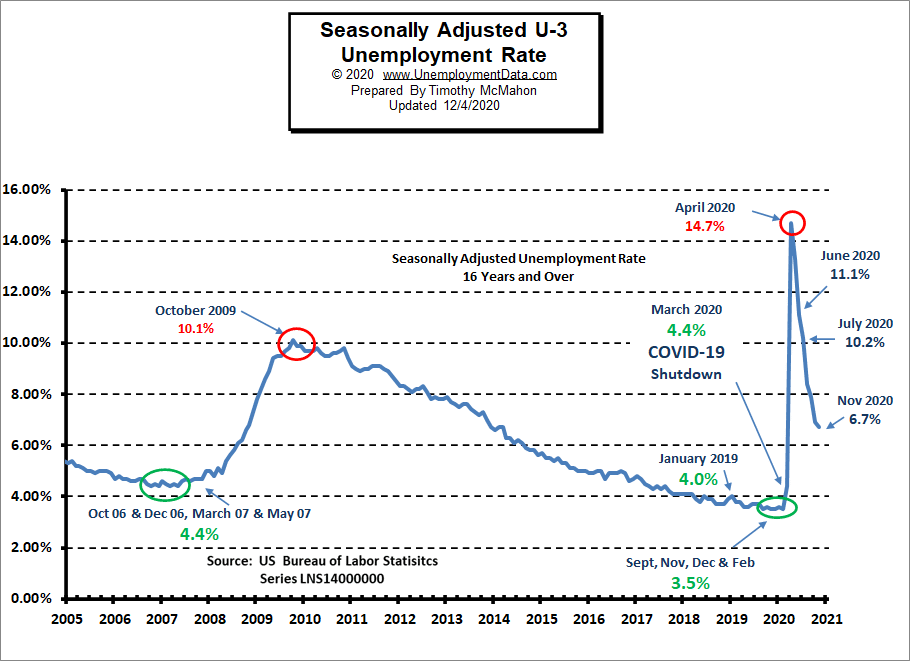
Unemployment by Education
Those unemployed with less than a High School Diploma fell from 21.2% in April to 15.4% in July and 9.8% in October to 9.0% in November. After bottoming at 4.8% in September 2019.
At the other end of the spectrum, those with a Bachelor’s degree or higher fell from 8.4% in April to 4.8% in September and 4.2% in October where it remained in November.
Typically those with a Bachelor’s degree are relatively immune to unemployment. Although during the 2008 recession college grads’ unemployment rose to slightly above 4%.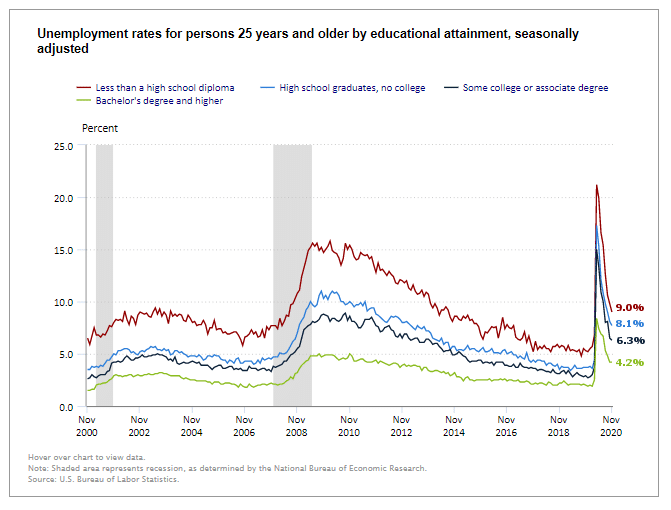
Source: Bureau of Labor Statistics
Layoff Status
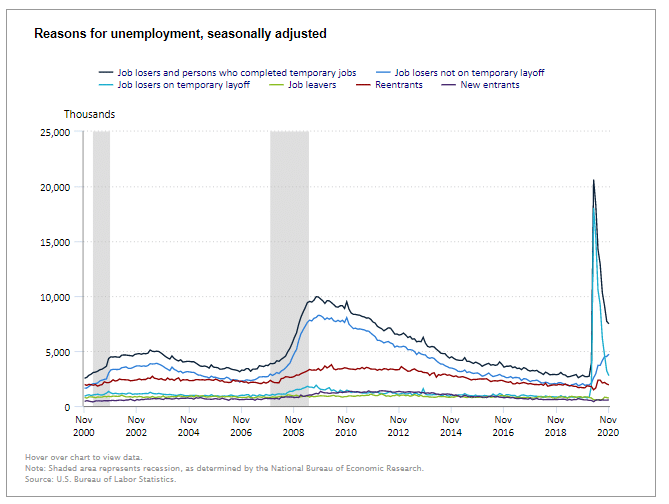
Source: BLS
Duration of Unemployment
Since 2016 the time people remained unemployed remained relatively low. But, then the virus shutdown occurred and people were spending longer times unemployed. Now, unemployment times are returning to normal, although it is difficult to see in the chart above the percentage of those unemployed for 27 weeks and over are starting to climb. Which we can see better in the chart below.
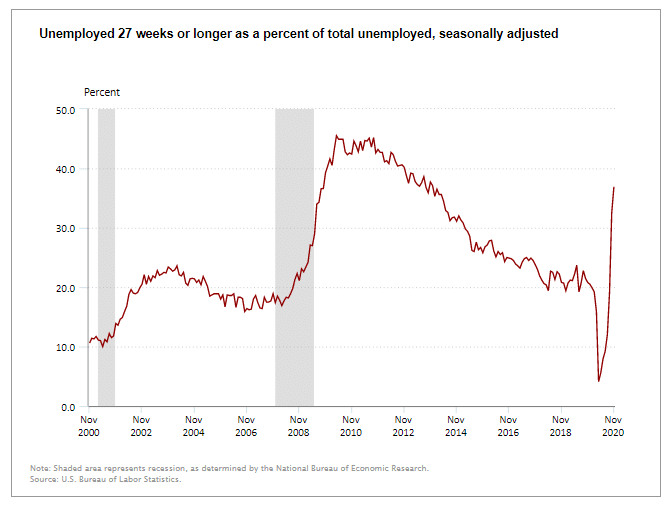
Labor Force Participation Rate
Even though Unemployment was in record low territory for quite some time, it wasn’t until January and February 2020, that the LFPR was finally able to claw its way back to 63.4%, its highest level since 2013.
Then COVID decimated all those gains dropping the LFPR down to 60.2% in April. In May it began to rebound and in June the LFPR was able to bounce back a little more to 61.5%, it fell slightly in July but this was probably due to people returning to the labor force rather than other factors. Over the last few months, the LFPR has bounced around between 61.4% and 61.7%.
See Labor Force Participation Rate for more information.
If you would like to receive this monthly report and other article updates click here you can unsubscribe at any time.
Here are some articles you might enjoy in case you missed them:
Read more on UnemploymentData.com.
- 6 Ways You Can Reset Your Career
- A Guide to Avoiding Unemployment After High School
- How to Improve Your Job Hunt
- Denied Workers’ Comp: How to Get the Money You Deserve
- Healthcare Careers on the Rise
From InflationData.com
- Annual Inflation in October is 1.18%
- Emerging Technologies
- A Better Understanding of How IRS Audits Work
- September Inflation Virtually Unchanged
- The Price of Oil Denominated in Bitcoin
- How has Venezuela’s Bitcoin experiment Fared?
From Financial Trend Forecaster
- China Ramps Up U.S. Crude Oil Imports
- Speed and Affordability: Cost of Internet Access Over Time
- New Technologies in the Oil and Gas Industry
- Oil Majors That Bet Big On Renewables
From Elliott Wave University
- This High-Confident Trade Set-up Makes for Highly-Confident Traders
- Bond Market: “When Investors Should Worry”
- Does the Stock Market Really “See” the Future?
- Gold: See What This Fibonacci Ratio Says About the Trend
- Forecasting Markets by Looking at Chart Patterns
From OptioMoney.com
- 5 Things to Consider When Managing Money in a Relationship
- Should You Buy a Second Home?
- Learning to Trade from Video Tutorials
- Five Business Tips to Help Your Company Thrive
From Your Family Finances

